Analysis of Peter Block's Stewardship Model and its Challenges
VerifiedAdded on 2021/05/31
|7
|1889
|28
Essay
AI Summary
This essay provides a comprehensive analysis of Peter Block's stewardship model, a leadership approach emphasizing partnership, service over self-interest, and shared responsibility. The essay begins by defining stewardship according to Block, highlighting its focus on ownership, accountability, and improved outcomes through indirect control and client participation. It contrasts stewardship with patriarchal leadership, advocating for partnership and minimized bureaucracy. Key elements discussed include prioritizing service over self-interest, promoting staff empowerment, and establishing governing principles such as de-glorifying management, embracing openness, redistributing wealth, and integrating management with the workforce. The essay then examines the roles of staff and line workers within the stewardship model, emphasizing their interconnectedness. Furthermore, it explores the benefits of stewardship in learning institutions, such as improved administration, shared decision-making, and enhanced accountability. Finally, it addresses the challenges associated with implementing this model, including resistance to change and potential policy missteps, providing a balanced perspective on Block's stewardship model.
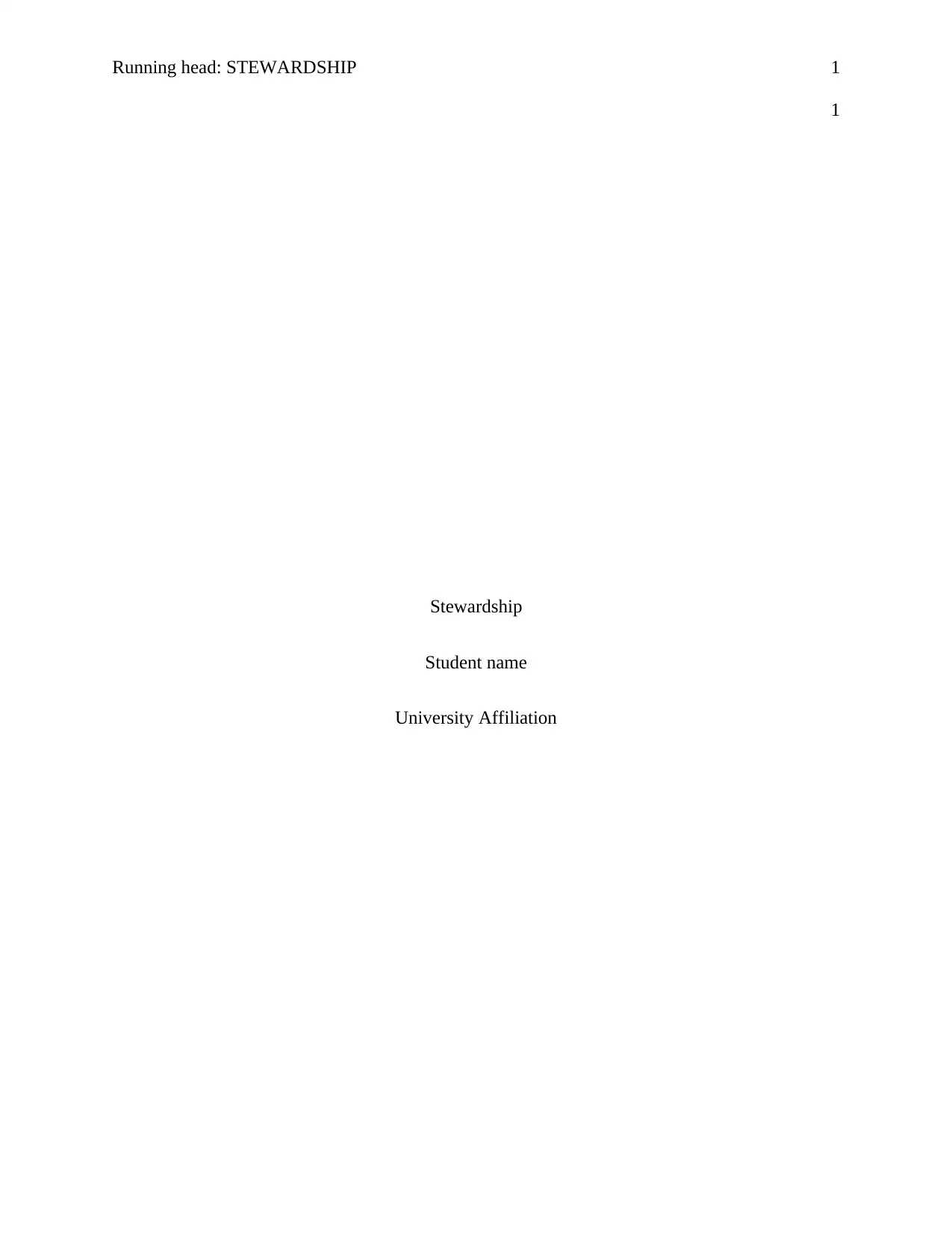
Running head: STEWARDSHIP 1
1
Stewardship
Student name
University Affiliation
1
Stewardship
Student name
University Affiliation
Paraphrase This Document
Need a fresh take? Get an instant paraphrase of this document with our AI Paraphraser
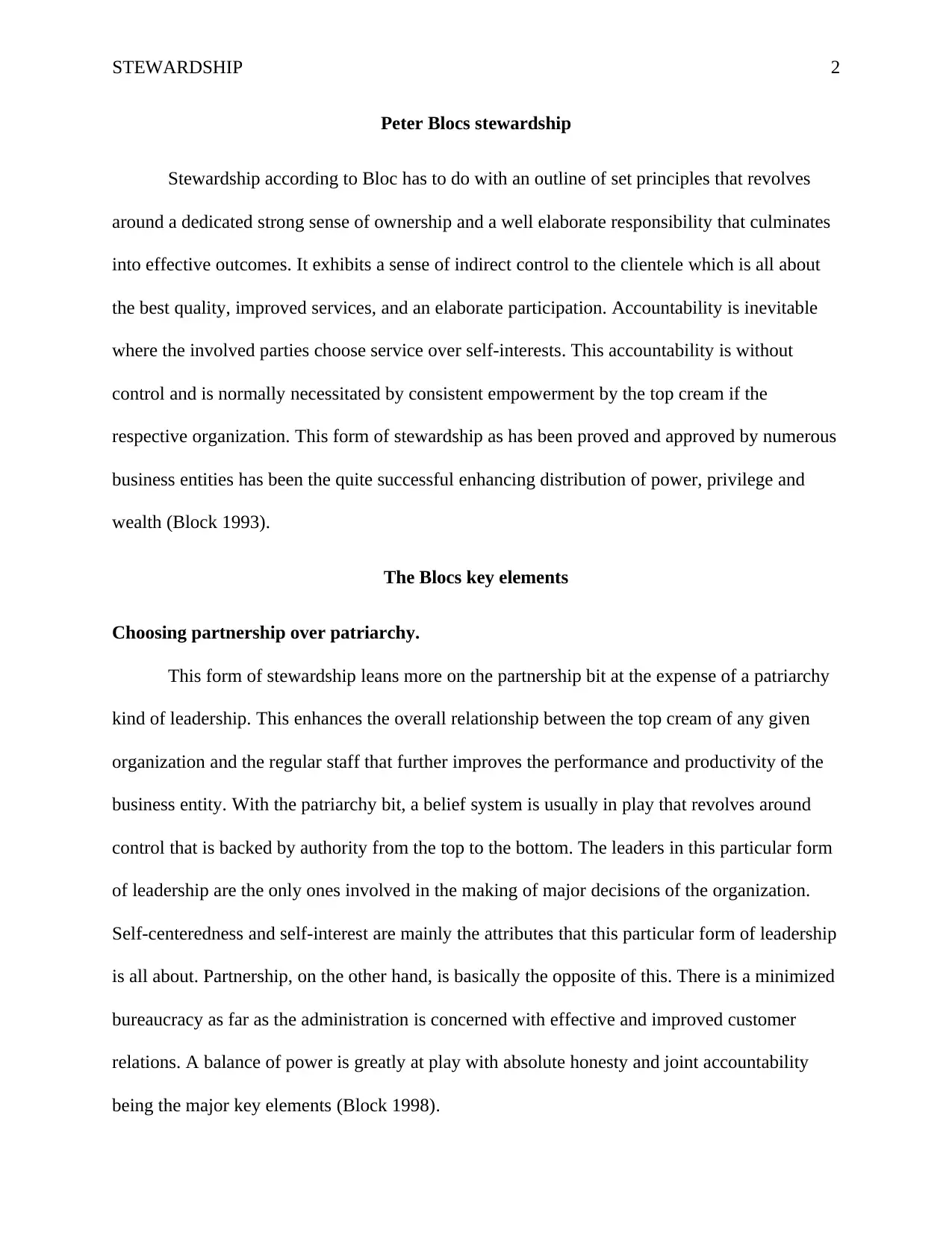
STEWARDSHIP 2
Peter Blocs stewardship
Stewardship according to Bloc has to do with an outline of set principles that revolves
around a dedicated strong sense of ownership and a well elaborate responsibility that culminates
into effective outcomes. It exhibits a sense of indirect control to the clientele which is all about
the best quality, improved services, and an elaborate participation. Accountability is inevitable
where the involved parties choose service over self-interests. This accountability is without
control and is normally necessitated by consistent empowerment by the top cream if the
respective organization. This form of stewardship as has been proved and approved by numerous
business entities has been the quite successful enhancing distribution of power, privilege and
wealth (Block 1993).
The Blocs key elements
Choosing partnership over patriarchy.
This form of stewardship leans more on the partnership bit at the expense of a patriarchy
kind of leadership. This enhances the overall relationship between the top cream of any given
organization and the regular staff that further improves the performance and productivity of the
business entity. With the patriarchy bit, a belief system is usually in play that revolves around
control that is backed by authority from the top to the bottom. The leaders in this particular form
of leadership are the only ones involved in the making of major decisions of the organization.
Self-centeredness and self-interest are mainly the attributes that this particular form of leadership
is all about. Partnership, on the other hand, is basically the opposite of this. There is a minimized
bureaucracy as far as the administration is concerned with effective and improved customer
relations. A balance of power is greatly at play with absolute honesty and joint accountability
being the major key elements (Block 1998).
Peter Blocs stewardship
Stewardship according to Bloc has to do with an outline of set principles that revolves
around a dedicated strong sense of ownership and a well elaborate responsibility that culminates
into effective outcomes. It exhibits a sense of indirect control to the clientele which is all about
the best quality, improved services, and an elaborate participation. Accountability is inevitable
where the involved parties choose service over self-interests. This accountability is without
control and is normally necessitated by consistent empowerment by the top cream if the
respective organization. This form of stewardship as has been proved and approved by numerous
business entities has been the quite successful enhancing distribution of power, privilege and
wealth (Block 1993).
The Blocs key elements
Choosing partnership over patriarchy.
This form of stewardship leans more on the partnership bit at the expense of a patriarchy
kind of leadership. This enhances the overall relationship between the top cream of any given
organization and the regular staff that further improves the performance and productivity of the
business entity. With the patriarchy bit, a belief system is usually in play that revolves around
control that is backed by authority from the top to the bottom. The leaders in this particular form
of leadership are the only ones involved in the making of major decisions of the organization.
Self-centeredness and self-interest are mainly the attributes that this particular form of leadership
is all about. Partnership, on the other hand, is basically the opposite of this. There is a minimized
bureaucracy as far as the administration is concerned with effective and improved customer
relations. A balance of power is greatly at play with absolute honesty and joint accountability
being the major key elements (Block 1998).
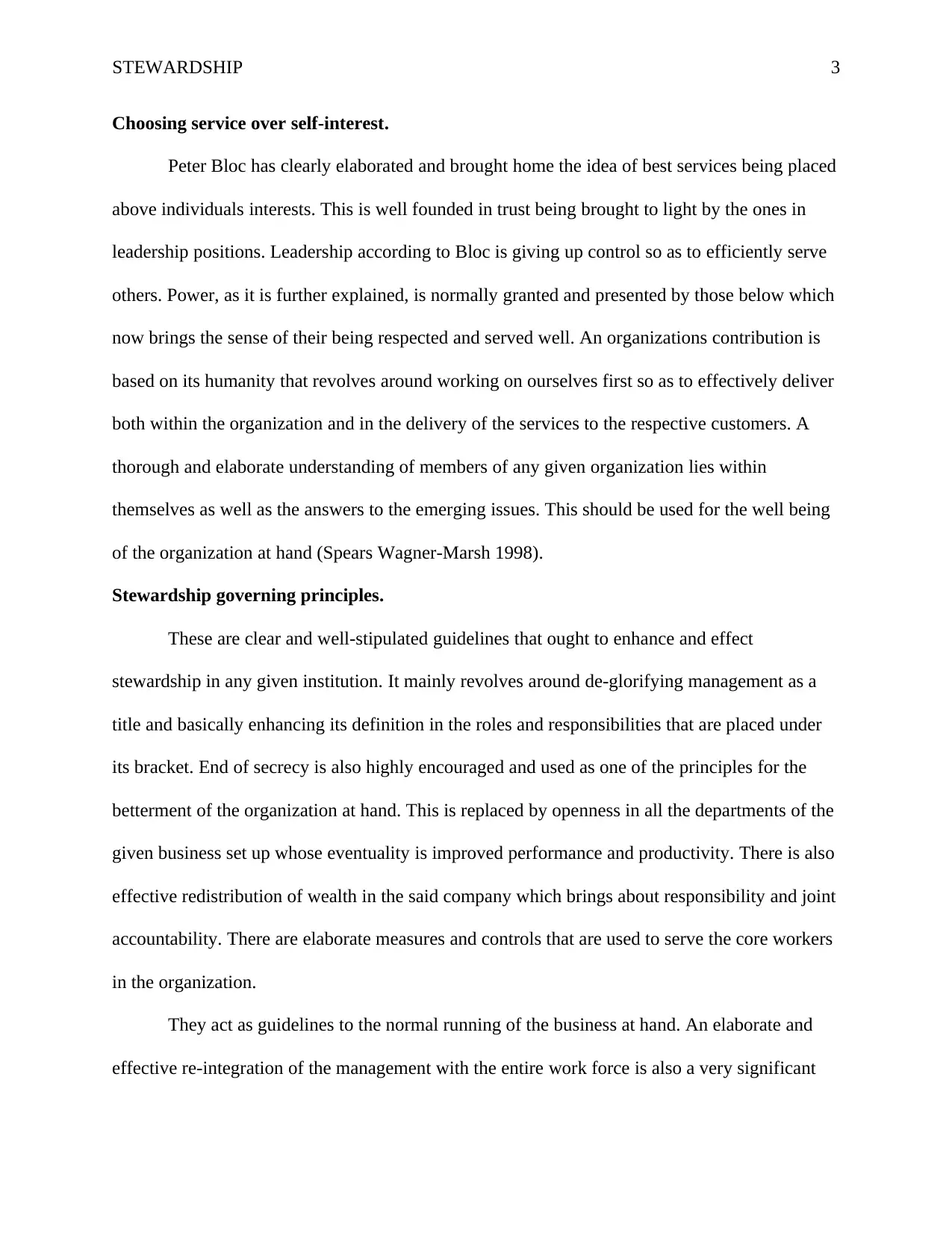
STEWARDSHIP 3
Choosing service over self-interest.
Peter Bloc has clearly elaborated and brought home the idea of best services being placed
above individuals interests. This is well founded in trust being brought to light by the ones in
leadership positions. Leadership according to Bloc is giving up control so as to efficiently serve
others. Power, as it is further explained, is normally granted and presented by those below which
now brings the sense of their being respected and served well. An organizations contribution is
based on its humanity that revolves around working on ourselves first so as to effectively deliver
both within the organization and in the delivery of the services to the respective customers. A
thorough and elaborate understanding of members of any given organization lies within
themselves as well as the answers to the emerging issues. This should be used for the well being
of the organization at hand (Spears Wagner-Marsh 1998).
Stewardship governing principles.
These are clear and well-stipulated guidelines that ought to enhance and effect
stewardship in any given institution. It mainly revolves around de-glorifying management as a
title and basically enhancing its definition in the roles and responsibilities that are placed under
its bracket. End of secrecy is also highly encouraged and used as one of the principles for the
betterment of the organization at hand. This is replaced by openness in all the departments of the
given business set up whose eventuality is improved performance and productivity. There is also
effective redistribution of wealth in the said company which brings about responsibility and joint
accountability. There are elaborate measures and controls that are used to serve the core workers
in the organization.
They act as guidelines to the normal running of the business at hand. An elaborate and
effective re-integration of the management with the entire work force is also a very significant
Choosing service over self-interest.
Peter Bloc has clearly elaborated and brought home the idea of best services being placed
above individuals interests. This is well founded in trust being brought to light by the ones in
leadership positions. Leadership according to Bloc is giving up control so as to efficiently serve
others. Power, as it is further explained, is normally granted and presented by those below which
now brings the sense of their being respected and served well. An organizations contribution is
based on its humanity that revolves around working on ourselves first so as to effectively deliver
both within the organization and in the delivery of the services to the respective customers. A
thorough and elaborate understanding of members of any given organization lies within
themselves as well as the answers to the emerging issues. This should be used for the well being
of the organization at hand (Spears Wagner-Marsh 1998).
Stewardship governing principles.
These are clear and well-stipulated guidelines that ought to enhance and effect
stewardship in any given institution. It mainly revolves around de-glorifying management as a
title and basically enhancing its definition in the roles and responsibilities that are placed under
its bracket. End of secrecy is also highly encouraged and used as one of the principles for the
betterment of the organization at hand. This is replaced by openness in all the departments of the
given business set up whose eventuality is improved performance and productivity. There is also
effective redistribution of wealth in the said company which brings about responsibility and joint
accountability. There are elaborate measures and controls that are used to serve the core workers
in the organization.
They act as guidelines to the normal running of the business at hand. An elaborate and
effective re-integration of the management with the entire work force is also a very significant
⊘ This is a preview!⊘
Do you want full access?
Subscribe today to unlock all pages.

Trusted by 1+ million students worldwide
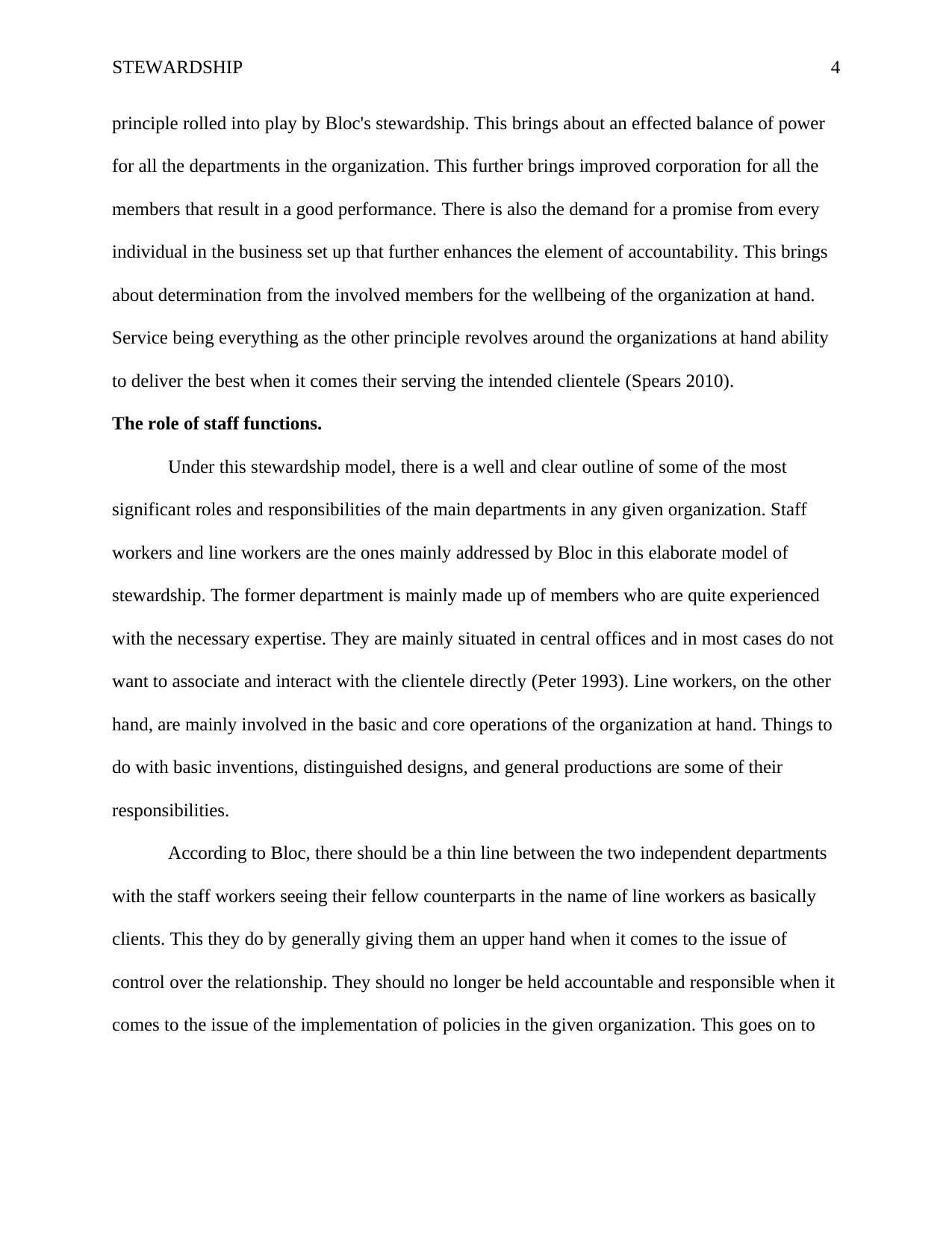
STEWARDSHIP 4
principle rolled into play by Bloc's stewardship. This brings about an effected balance of power
for all the departments in the organization. This further brings improved corporation for all the
members that result in a good performance. There is also the demand for a promise from every
individual in the business set up that further enhances the element of accountability. This brings
about determination from the involved members for the wellbeing of the organization at hand.
Service being everything as the other principle revolves around the organizations at hand ability
to deliver the best when it comes their serving the intended clientele (Spears 2010).
The role of staff functions.
Under this stewardship model, there is a well and clear outline of some of the most
significant roles and responsibilities of the main departments in any given organization. Staff
workers and line workers are the ones mainly addressed by Bloc in this elaborate model of
stewardship. The former department is mainly made up of members who are quite experienced
with the necessary expertise. They are mainly situated in central offices and in most cases do not
want to associate and interact with the clientele directly (Peter 1993). Line workers, on the other
hand, are mainly involved in the basic and core operations of the organization at hand. Things to
do with basic inventions, distinguished designs, and general productions are some of their
responsibilities.
According to Bloc, there should be a thin line between the two independent departments
with the staff workers seeing their fellow counterparts in the name of line workers as basically
clients. This they do by generally giving them an upper hand when it comes to the issue of
control over the relationship. They should no longer be held accountable and responsible when it
comes to the issue of the implementation of policies in the given organization. This goes on to
principle rolled into play by Bloc's stewardship. This brings about an effected balance of power
for all the departments in the organization. This further brings improved corporation for all the
members that result in a good performance. There is also the demand for a promise from every
individual in the business set up that further enhances the element of accountability. This brings
about determination from the involved members for the wellbeing of the organization at hand.
Service being everything as the other principle revolves around the organizations at hand ability
to deliver the best when it comes their serving the intended clientele (Spears 2010).
The role of staff functions.
Under this stewardship model, there is a well and clear outline of some of the most
significant roles and responsibilities of the main departments in any given organization. Staff
workers and line workers are the ones mainly addressed by Bloc in this elaborate model of
stewardship. The former department is mainly made up of members who are quite experienced
with the necessary expertise. They are mainly situated in central offices and in most cases do not
want to associate and interact with the clientele directly (Peter 1993). Line workers, on the other
hand, are mainly involved in the basic and core operations of the organization at hand. Things to
do with basic inventions, distinguished designs, and general productions are some of their
responsibilities.
According to Bloc, there should be a thin line between the two independent departments
with the staff workers seeing their fellow counterparts in the name of line workers as basically
clients. This they do by generally giving them an upper hand when it comes to the issue of
control over the relationship. They should no longer be held accountable and responsible when it
comes to the issue of the implementation of policies in the given organization. This goes on to
Paraphrase This Document
Need a fresh take? Get an instant paraphrase of this document with our AI Paraphraser
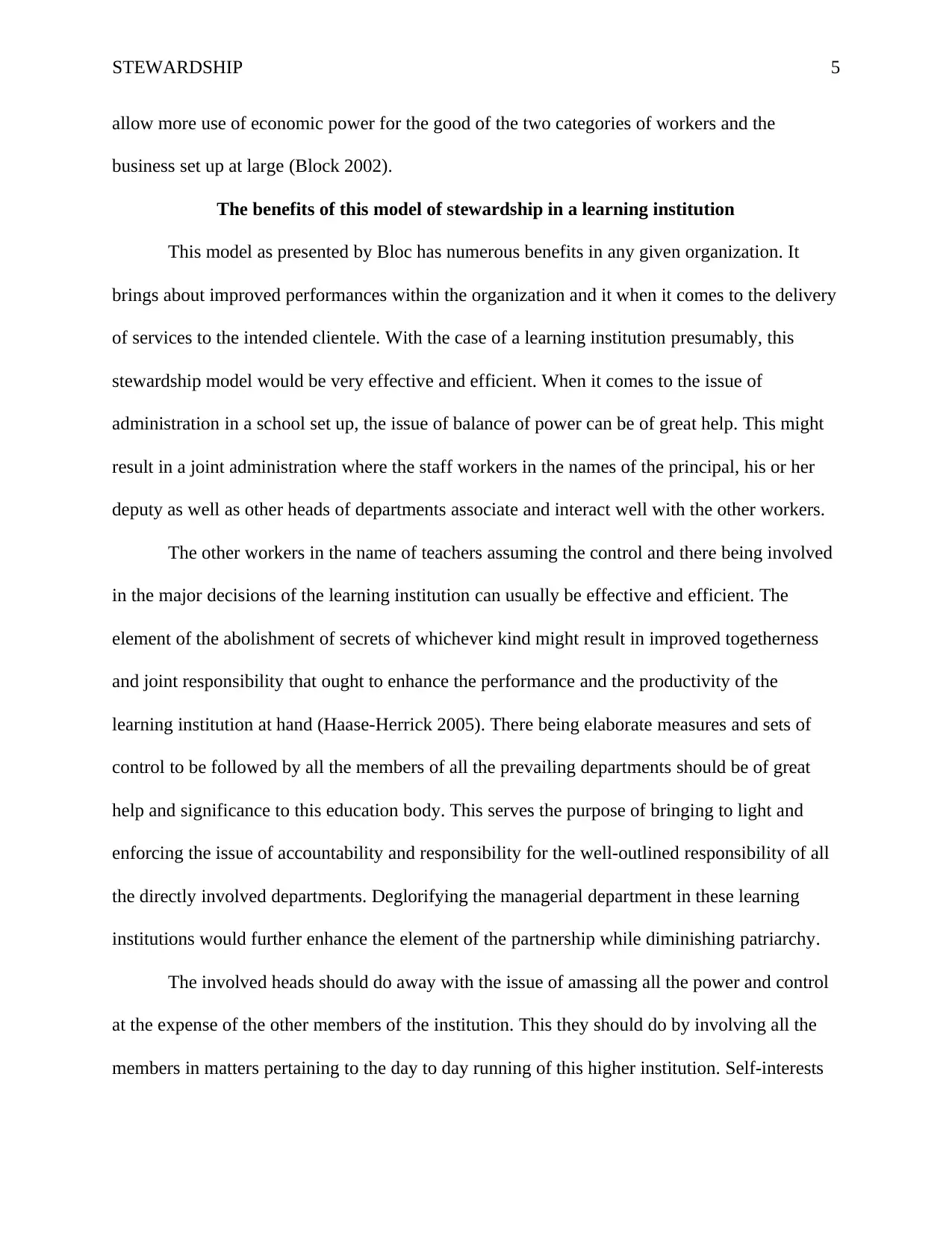
STEWARDSHIP 5
allow more use of economic power for the good of the two categories of workers and the
business set up at large (Block 2002).
The benefits of this model of stewardship in a learning institution
This model as presented by Bloc has numerous benefits in any given organization. It
brings about improved performances within the organization and it when it comes to the delivery
of services to the intended clientele. With the case of a learning institution presumably, this
stewardship model would be very effective and efficient. When it comes to the issue of
administration in a school set up, the issue of balance of power can be of great help. This might
result in a joint administration where the staff workers in the names of the principal, his or her
deputy as well as other heads of departments associate and interact well with the other workers.
The other workers in the name of teachers assuming the control and there being involved
in the major decisions of the learning institution can usually be effective and efficient. The
element of the abolishment of secrets of whichever kind might result in improved togetherness
and joint responsibility that ought to enhance the performance and the productivity of the
learning institution at hand (Haase-Herrick 2005). There being elaborate measures and sets of
control to be followed by all the members of all the prevailing departments should be of great
help and significance to this education body. This serves the purpose of bringing to light and
enforcing the issue of accountability and responsibility for the well-outlined responsibility of all
the directly involved departments. Deglorifying the managerial department in these learning
institutions would further enhance the element of the partnership while diminishing patriarchy.
The involved heads should do away with the issue of amassing all the power and control
at the expense of the other members of the institution. This they should do by involving all the
members in matters pertaining to the day to day running of this higher institution. Self-interests
allow more use of economic power for the good of the two categories of workers and the
business set up at large (Block 2002).
The benefits of this model of stewardship in a learning institution
This model as presented by Bloc has numerous benefits in any given organization. It
brings about improved performances within the organization and it when it comes to the delivery
of services to the intended clientele. With the case of a learning institution presumably, this
stewardship model would be very effective and efficient. When it comes to the issue of
administration in a school set up, the issue of balance of power can be of great help. This might
result in a joint administration where the staff workers in the names of the principal, his or her
deputy as well as other heads of departments associate and interact well with the other workers.
The other workers in the name of teachers assuming the control and there being involved
in the major decisions of the learning institution can usually be effective and efficient. The
element of the abolishment of secrets of whichever kind might result in improved togetherness
and joint responsibility that ought to enhance the performance and the productivity of the
learning institution at hand (Haase-Herrick 2005). There being elaborate measures and sets of
control to be followed by all the members of all the prevailing departments should be of great
help and significance to this education body. This serves the purpose of bringing to light and
enforcing the issue of accountability and responsibility for the well-outlined responsibility of all
the directly involved departments. Deglorifying the managerial department in these learning
institutions would further enhance the element of the partnership while diminishing patriarchy.
The involved heads should do away with the issue of amassing all the power and control
at the expense of the other members of the institution. This they should do by involving all the
members in matters pertaining to the day to day running of this higher institution. Self-interests
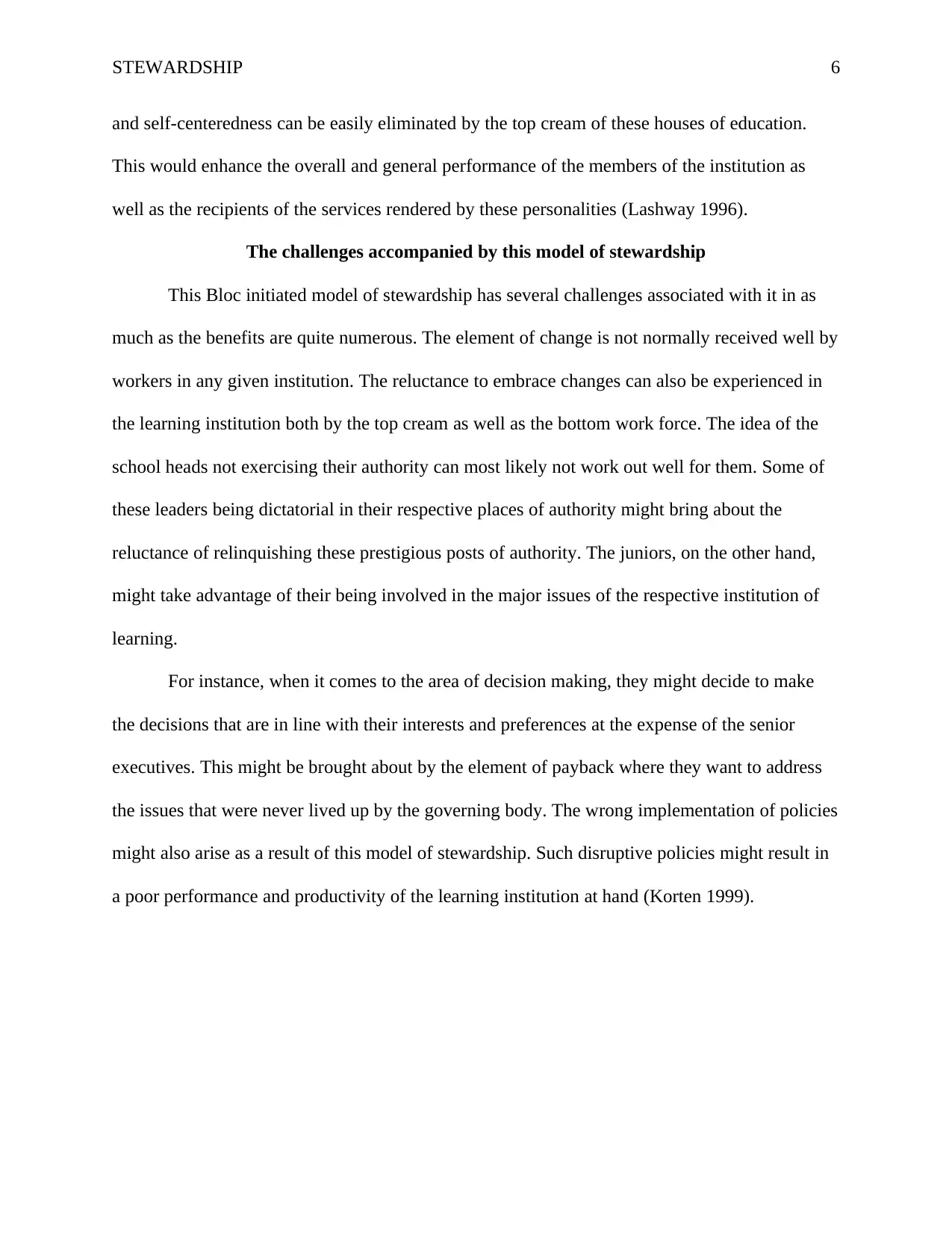
STEWARDSHIP 6
and self-centeredness can be easily eliminated by the top cream of these houses of education.
This would enhance the overall and general performance of the members of the institution as
well as the recipients of the services rendered by these personalities (Lashway 1996).
The challenges accompanied by this model of stewardship
This Bloc initiated model of stewardship has several challenges associated with it in as
much as the benefits are quite numerous. The element of change is not normally received well by
workers in any given institution. The reluctance to embrace changes can also be experienced in
the learning institution both by the top cream as well as the bottom work force. The idea of the
school heads not exercising their authority can most likely not work out well for them. Some of
these leaders being dictatorial in their respective places of authority might bring about the
reluctance of relinquishing these prestigious posts of authority. The juniors, on the other hand,
might take advantage of their being involved in the major issues of the respective institution of
learning.
For instance, when it comes to the area of decision making, they might decide to make
the decisions that are in line with their interests and preferences at the expense of the senior
executives. This might be brought about by the element of payback where they want to address
the issues that were never lived up by the governing body. The wrong implementation of policies
might also arise as a result of this model of stewardship. Such disruptive policies might result in
a poor performance and productivity of the learning institution at hand (Korten 1999).
and self-centeredness can be easily eliminated by the top cream of these houses of education.
This would enhance the overall and general performance of the members of the institution as
well as the recipients of the services rendered by these personalities (Lashway 1996).
The challenges accompanied by this model of stewardship
This Bloc initiated model of stewardship has several challenges associated with it in as
much as the benefits are quite numerous. The element of change is not normally received well by
workers in any given institution. The reluctance to embrace changes can also be experienced in
the learning institution both by the top cream as well as the bottom work force. The idea of the
school heads not exercising their authority can most likely not work out well for them. Some of
these leaders being dictatorial in their respective places of authority might bring about the
reluctance of relinquishing these prestigious posts of authority. The juniors, on the other hand,
might take advantage of their being involved in the major issues of the respective institution of
learning.
For instance, when it comes to the area of decision making, they might decide to make
the decisions that are in line with their interests and preferences at the expense of the senior
executives. This might be brought about by the element of payback where they want to address
the issues that were never lived up by the governing body. The wrong implementation of policies
might also arise as a result of this model of stewardship. Such disruptive policies might result in
a poor performance and productivity of the learning institution at hand (Korten 1999).
⊘ This is a preview!⊘
Do you want full access?
Subscribe today to unlock all pages.

Trusted by 1+ million students worldwide
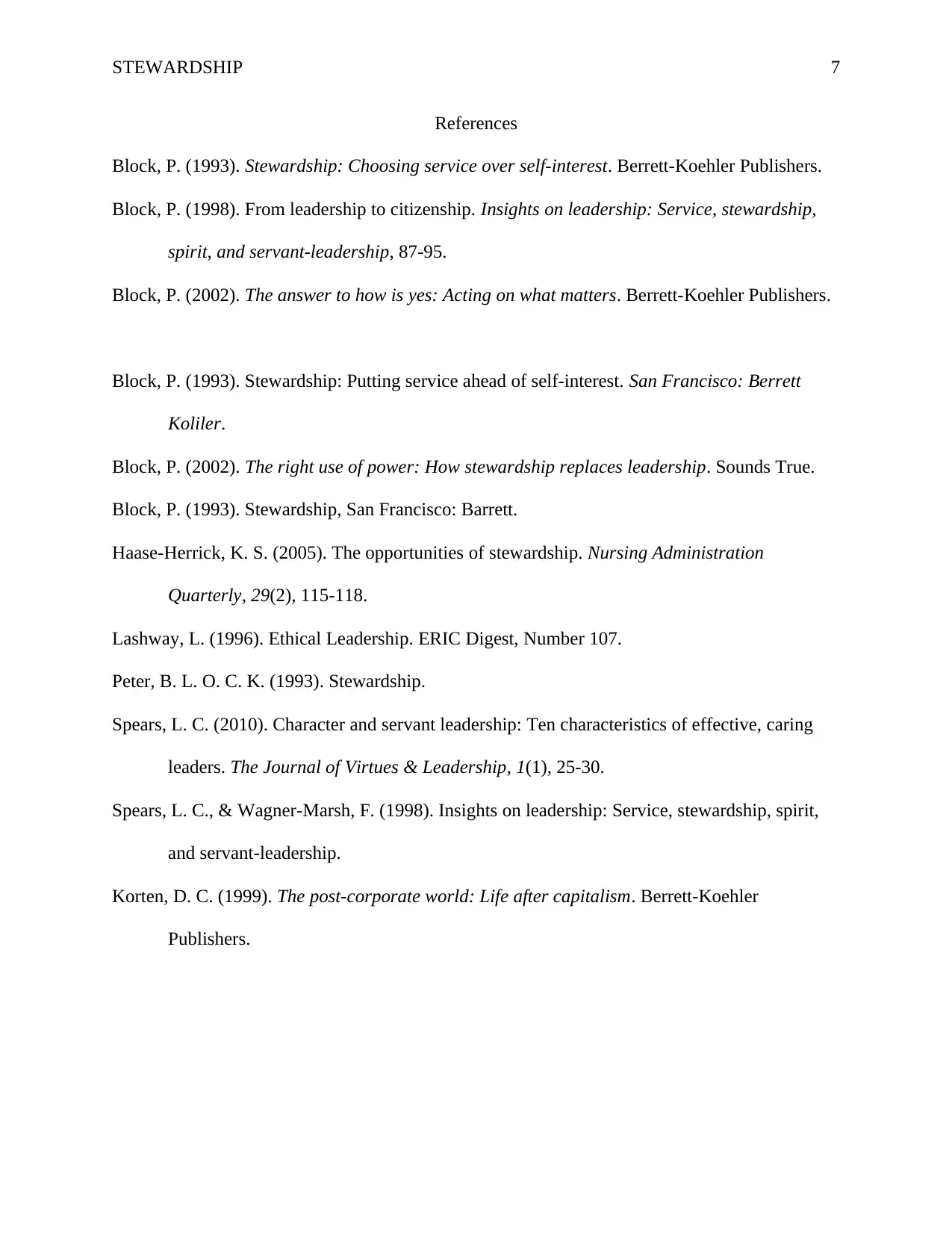
STEWARDSHIP 7
References
Block, P. (1993). Stewardship: Choosing service over self-interest. Berrett-Koehler Publishers.
Block, P. (1998). From leadership to citizenship. Insights on leadership: Service, stewardship,
spirit, and servant-leadership, 87-95.
Block, P. (2002). The answer to how is yes: Acting on what matters. Berrett-Koehler Publishers.
Block, P. (1993). Stewardship: Putting service ahead of self-interest. San Francisco: Berrett
Koliler.
Block, P. (2002). The right use of power: How stewardship replaces leadership. Sounds True.
Block, P. (1993). Stewardship, San Francisco: Barrett.
Haase-Herrick, K. S. (2005). The opportunities of stewardship. Nursing Administration
Quarterly, 29(2), 115-118.
Lashway, L. (1996). Ethical Leadership. ERIC Digest, Number 107.
Peter, B. L. O. C. K. (1993). Stewardship.
Spears, L. C. (2010). Character and servant leadership: Ten characteristics of effective, caring
leaders. The Journal of Virtues & Leadership, 1(1), 25-30.
Spears, L. C., & Wagner-Marsh, F. (1998). Insights on leadership: Service, stewardship, spirit,
and servant-leadership.
Korten, D. C. (1999). The post-corporate world: Life after capitalism. Berrett-Koehler
Publishers.
References
Block, P. (1993). Stewardship: Choosing service over self-interest. Berrett-Koehler Publishers.
Block, P. (1998). From leadership to citizenship. Insights on leadership: Service, stewardship,
spirit, and servant-leadership, 87-95.
Block, P. (2002). The answer to how is yes: Acting on what matters. Berrett-Koehler Publishers.
Block, P. (1993). Stewardship: Putting service ahead of self-interest. San Francisco: Berrett
Koliler.
Block, P. (2002). The right use of power: How stewardship replaces leadership. Sounds True.
Block, P. (1993). Stewardship, San Francisco: Barrett.
Haase-Herrick, K. S. (2005). The opportunities of stewardship. Nursing Administration
Quarterly, 29(2), 115-118.
Lashway, L. (1996). Ethical Leadership. ERIC Digest, Number 107.
Peter, B. L. O. C. K. (1993). Stewardship.
Spears, L. C. (2010). Character and servant leadership: Ten characteristics of effective, caring
leaders. The Journal of Virtues & Leadership, 1(1), 25-30.
Spears, L. C., & Wagner-Marsh, F. (1998). Insights on leadership: Service, stewardship, spirit,
and servant-leadership.
Korten, D. C. (1999). The post-corporate world: Life after capitalism. Berrett-Koehler
Publishers.
1 out of 7
Related Documents
Your All-in-One AI-Powered Toolkit for Academic Success.
+13062052269
info@desklib.com
Available 24*7 on WhatsApp / Email
![[object Object]](/_next/static/media/star-bottom.7253800d.svg)
Unlock your academic potential
Copyright © 2020–2025 A2Z Services. All Rights Reserved. Developed and managed by ZUCOL.



